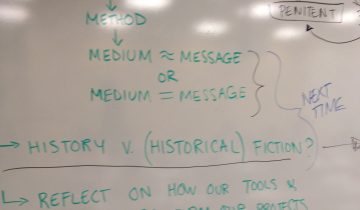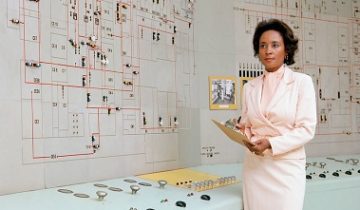For class this coming Wednesday we’ll talk about the issues that you specifically find most interesting and important. Please provide a link to an article you find in a reliable* news source along with a short (under 200 words) explanation of what issues the article brings up concerning digital labor, and what specifically you’d like to talk about with your classmates. If you can, try to connect your article to other historical or topical themes we’ve discussed in class: our goal will be to try to figure out how digital labor has changed over time and how it’s likely to continue to change in our lifetimes.
Please post your article links and essays no later than 12 noon on the day of class. And please return to this site an hour or 2 before we meet in person and take a look at the articles and essays that I have made visible. Don’t worry: even if your post isn’t visible, we can still talk about it in class. Reading some entries beforehand is just a way to give us some common ground for discussion.
_________
*“reliable” news sources are ones that have some sort of editorial oversight and editorial chain of review, which includes stringent fact-checking. For instance, The New York Times, The BBC, The Guardian (which as you recall was Snowden’s chosen instrument for his whistleblowing), Wired, The Atlantic, etc. Please try to stay away from news sources that rely on “on spec” writing by freelancers who have little oversight or responsibility to the publication for accuracy, or ones which have little or no fact-checking. Examples of these less reliable news sources are “infotainment” sites like Huffington Post, Fox News, Gizmodo, etc. If you find an article on a less reliable site that you *really* want to use, then try to see if the topic has been covered by a more reliable news outlet (and link to that article instead).




Here is the article I found on the Atlantic: http://www.theatlantic.com/technology/archive/2012/09/how-google-builds-its-maps-and-what-it-means-for-the-future-of-everything/261913/
This article in 2012 looks into how Google is building its mapping system. I found it interesting because it is not something that we take for granted (like CCM). I didn’t think that Google would spend so much effort on its map service although I admit that it’s doing better than Apple’s service. Still, I felt like it might not be as professional as GPS companies like Garmin which offer service with a cost. After reading this article, it’s surprising that they are actually using every source they can to strive for precision and are active in responding to problems. The human input in the service is huge–more than we expect.
It seems that the Internet is really connecting every dot. Google started to provide map service maybe just want to cater people’s need to navigate and to sell mobile phones. Now, the map service can also provide them the edge in self-driving car industry. This is a kind of digital labor that I feel positive of: “The secret to this success isn’t, as you might expect, Google’s facility with data, but rather its willingness to commit humans to combining and cleaning data about the physical world.”
http://www.livescience.com/52448-new-tech-freezes-drones.html
In this article, it talks about a new anti-drone defense system. I want to bring this article up because of a little irony I find in it. It seems that just in the last few years, drones have been introduced on a larger scale than just prototypes, and just as soon as they are getting “good”, the military needs to create technology to prevent wrongful or “terrorist” actions with them. The anti-drone system being tested disable’s the drone from being operated and eventually would drain its battery and crash it. They need to take these precautions due to the misuse of the drones. Drones that were designed to advance military war tactics and abilities, are now so commonplace that they need technology to protect places even on home soil from being “pranked” or attacked by troublemakers. They have already had accidents occur involving the White House’s lawn and drones crashing there. This is a perfect scenario where technology is developed for war and is further seen in regular life. Drones in general are an interesting topic, they replace humans to a point, but at the same time keep humans safe. Finding the right mix where they are useful enough, but not completely replacing the digital labor part of humans.
As we have previously discussed in class, Google search results and ads are sometimes biased. This TED Talk addresses how Google search results can be manipulated by regular people and how the company, Google, itself, is not unbiased and can be very subjective when it comes to regulating some search results. Andreas Ekstrom shows this by giving opposite examples of Michelle Obama and Andres Behring Breivik, a mass murderer in Norway, both who had their Google Images results manipulated and had differing reactions from Google.
http://www.ted.com/talks/andreas_ekstrom_the_moral_bias_behind_your_search_results#t-83518
The article that I chose is from the MIT Technology Review and titled “Why Self-Driving Cars Must Be Programmed To Kill.” The article discusses the viability of self-driving cars when the moral implications of saving lives are involved. In situations where an accident and potential fatalities are unavoidable the car will have to determine which lives to save. Besides the obvious implications of digital labor in the manufacture, design, and development of the cars, software, and algorithms the connection to our studies in digital labor that stood out to me was the utilization of Mechanical Turks by Bonnefon and his associates to analyze public opinion. This showed me how developed and pervasive digital labor has become. Every time I think I have a finite definition of what digital labor is, I stumble upon another facet. The definition of digital labor is ever evolving. What I would like to discuss with the class is how they think digital labor will evolve in the next 5 years. Should digital laborers have similar rights to traditional laborers? Is the distribution of benefits derived from digital labor skewed or lopsided; if so, in what way?
Article Link:
http://www.technologyreview.com/view/542626/why-self-driving-cars-must-be-programmed-to-kill/
The article I chose revolves around the future of Virtual Reality as technology that might become commonplace in the next few years. Although I don’t expect it to reach every single household in a few years there seems to be a large interest in the technology as several tech giants are pushing to get their own “VR” device on the marketplace. Two topics I’d like to specifically discuss would be “How do you expect VR will change your field if at all?” and “Are there any ethical concerns that should be considered when using VR?”
I wanted to bring up the ethical portion of this because we discussed moral panics in relation to Turkle. Moral panics have continually happened across history and I wanted to know if VR is going to take the same direction. So far the people I’ve talked to about this are also very excited to see what VR will bring.
http://learning.blogs.nytimes.com/2015/10/28/how-excited-are-you-about-the-possibilities-of-virtual-reality/
http://www.wired.com/2015/11/tinder-updates-its-algorithm-and-adds-smart-profiles/
We live in a time of constant social experiments, of mass data collection and a time where individuals of all walks of life can be categorized as “users”. We can confidently state that the technology we interact with serves a purpose in our daily lives, as different pieces of social media platforms and mobile applications assist in performing the most menial tasks. We check in, meet and date people, search for information and connect with people virtually. We’ve come to depend heavily on social platforms to play an active role in our lives.
But there comes a point in every innovative and forward thinking tech where the newness of technology starts to wear off and we begin to ask ourselves what purpose these apps and social platforms really serve? Companies are constantly updating, redesigning and adding new features to these social spaces that are meant to make the user experience more intuitive, user friendly, and adaptable to our needs.
Take the example of Tinder, a mobile dating app meant to “empower users around the world to create new connections that otherwise might have never been possible…build[ing] products that bring people together” With the swipe of a finger, mutually interested individuals can connect without much fuss. The entire concept of this platform is based around simplicity, a no frills interface allowing people to focus on what’s important to them. Recently Tinder redesigned their app to allow users the option of including their job and education information in their profiles, a small change to include information that users were already including in their profiles. However, the real change will occur in the changes that have been made with Tinder’s algorithms and the introduction of their “Smart Profiles” which will use profile information, including education and employment to help match people. According to the article I read, Tinder’s smart profiles will do more than just match compatible users but it will essentially make decisions on what “the most pertinent piece of information” in user profiles is, in order to determine what to other compatible users.
In class we’ve dedicated a bit of time discussing algorithms and the role they play in every interaction we have online. Because companies are very protective of their intellectual property, the inner working of how algorithms function within our social spaces is still unknown. Users assume that technology is unbiased and ethical but what most users fail to realize is that the social spaces we live in are created and enhanced by human minds who possess their own moral and ethical beliefs.
With the constant changes in app features and enhancements to the data collected from users, the question of who is driving who remains unanswered. What fuels the changes in these social spaces and do these changes prompt us as users to modify our behavior? Have users become an extension of algorithms, which in turn are an extension developers?
http://www.nytimes.com/2015/11/17/world/europe/encrypted-messaging-apps-face-new-scrutiny-over-possible-role-in-paris-attacks.html?smid=pl-share&_r=0
I’m sure anything related to the tragic events that happened in Paris last week was a popular choice among articles selected for this assignment, but his article stood out for me for a few other reasons. I felt that it shows a real connection to the origins of computer technology, as it seems like this technology has made a complete reversal from its original use. I found it interesting that computers developed out of the need for allied forces to break encrypted massages being sent to and from Nazi Germany during World War II, and now that very technology has evolved to programs that enable private users to encrypt their messages and personal information. Though the original intentions for this technology were good, such as protecting private information like bank account numbers from being used by criminals – it has now become a problem for domestic and international security. The problem is: how do governments gain access to certain communications to possibly prevent an attack without compromising their citizens’ privacy and rights?
Nonprofit Makes 3-D Digital Archives of Endangered Heritage Sites: http://observer.com/2015/10/non-profit-makes-3-d-digital-archives-of-endangered-heritage-sites/
Digital archiving is a form of digital labor and like our discussion on algorithms, the act of archiving can sometimes have bias which can influence our understanding of history. This project shows that archiving can also take place in 3D form and not just through 2D documentation. The idea of trying to preserve architecture through model replications is new to me, since I thought archiving was only applied to ideas and could only be done through conventional methods. This project is also relevant since world heritage sites are diminishing faster than ever, especially in war-torn areas of the world.
http://spectrum.ieee.org/automaton/robotics/humanoids/how-robonaut-2-will-help-astronauts-in-space
This article is an overview of a new automaton that is being sent to the International Space Station to assist the astronauts. I chose this article because of how it describes the replacement of human tasks with robotics in order to increase productivity and efficiency. This is of special interest to me because of my interests in the field of space and the new robotic system may lead to a wipe-out of the need for human astronauts all together in space exploration.
This article is related to the Facebook article as it talks about using robotics to allow a group to be more attuned to other tasks rather than simple ones, the new robot may lead to improvements in research aboard the ISS and will help the productivity of the astronauts on board.